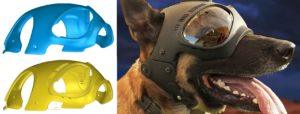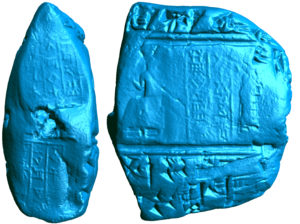In the last 30 years, Laser Design has participated in, facilitated, and supplied equipment to a number of 3D scanning projects. Our experiences in the field and in the laboratory have shown us the sheer breadth of this technology and the range of objectives it can accomplish. Would you believe that our scanners have passed over everything from a live lobster to the President of the United States?
With the right scanner and 3D scanning software, even novices can create detailed, digital representations of a physical object. Let’s take a look at some of the most fascinating projects we’ve encountered over the years.
1. U.S. Women’s National Soccer Team
 A significant advantage of 3D scanning over other modeling technologies is that this approach is non-destructive and safe for humans. That made it possible to scan the U.S. Women’s National Soccer Team in order to create custom foosball tables featuring the players.
A significant advantage of 3D scanning over other modeling technologies is that this approach is non-destructive and safe for humans. That made it possible to scan the U.S. Women’s National Soccer Team in order to create custom foosball tables featuring the players.
Due to the time constraints of the team’s schedule, the body scan needed to be completed and verified in under 5 minutes per player. That gave us just enough time for one scan (no redos!) and a completeness check. The Artec Eva 3D scanner was the perfect choice for this time-sensitive project, and each scan ended up taking just 2 minutes. From there, Laser Design’s 3D models were imported, edited, and printed to create unique figures for the foosball tables.
2. A Live Lobster
One benefit of certain Artec 3D scanners is that they can capture motion, making them ideal for moving subjects—such as, say, a lobster. When an East Coast research team needed a high-resolution image of the live crustacean, we knew that the Artec Space Spider was the perfect model to capture minute details while allowing for the animal’s natural movement. The handheld yet powerful design of this 3D scanner made it an ideal choice for working in close quarters and generating a comprehensive scan of the creature.
3. Kensington Runestone
Did you know we’ve even been on television? That’s right, 3D scanning is glamorous enough for the small screen! Archaeologists from “America’s Lost Vikings” reached out to Laser Design for assistance in creating an extremely detailed 3D model of the controversial Kensington Runestone. Experts have been arguing for years over whether the stone is an authentic artifact or something planted and then “found” by a farmer in 1898, and this episode of the show was dedicated to finding out exactly how old the thing is.
We decided to use both the Artec Eva and Space Spider to create a cohesive 3D image—in color! This allowed the archaeologists to closely study the depth of the carvings in the stone and predict how they should have weathered if the stone had really been exposed to the elements for hundreds of years.
4. Canine Headgear
 Reverse engineering is yet another task made easier with the help of a 3D scanner. K9 Helm came to Laser Design with a hand-sculpted prototype of a protective helmet, meant to be worn by canines taking part in human rescue operations. This cranial device was intended to provide an effective anchoring spot for gear such as cameras, lights, muzzles, and ear protection. But before the company could continue with their product development, they needed detailed CAD models that would allow them to 3D print further test models.
Reverse engineering is yet another task made easier with the help of a 3D scanner. K9 Helm came to Laser Design with a hand-sculpted prototype of a protective helmet, meant to be worn by canines taking part in human rescue operations. This cranial device was intended to provide an effective anchoring spot for gear such as cameras, lights, muzzles, and ear protection. But before the company could continue with their product development, they needed detailed CAD models that would allow them to 3D print further test models.
We used a portable Artec 3D scanner, specifically the Spider, to scan the prototype model and create a Solidworks parametric model that could then be used to 3D print a testable helmet. This method of reverse engineering was particularly helpful (and necessary) because the original prototype was handcrafted to fit the anatomy of a dog, and no computer models existed yet!
5. Centuries-Old Biblical Artifacts
 The field of archaeology has been well-served by 3D scanning technology. This non-destructive, non-contact imaging method allows fragile pieces to be digitally preserved with no risk to the original. The Museum of the Bible was looking for a preservation option that would also allow them to study their artifacts more closely, and 3D scanning fit the need exactly. Specifically, portable Artec 3D scanners provided the perfect solution.
The field of archaeology has been well-served by 3D scanning technology. This non-destructive, non-contact imaging method allows fragile pieces to be digitally preserved with no risk to the original. The Museum of the Bible was looking for a preservation option that would also allow them to study their artifacts more closely, and 3D scanning fit the need exactly. Specifically, portable Artec 3D scanners provided the perfect solution.
Laser Design used the Artec Spider to scan a cuneiform tablet and an inscribed bowl, both of which were thousands of years old. The resulting 3D models allowed the Museum experts to study the pieces in far more detail than traditional photography is able to provide. Custom 3D scanning software lighting schemes exposed details that would be impossible to pick out on the original artifact itself!
3D Scanners and Scanning Services From Laser Design
Clearly, 3D scanning can be used for an incredible variety of projects. We’re proud to supply high-quality scanning equipment and services to customers across a range of industries. Whether you’re reverse engineering a product component or working on animating a dog, Laser Design can provide the tools and expertise needed to make your project run smoothly. We’re always happy to answer questions about the 3D scanning process and help you find the right equipment—give us a call today to learn more!
